One-Dimensional Plume Dispersion Modeling in Marine Conditions (SEDPLUME1D-Model)
Abstract
1. Introduction
2. Methods and Models
3. Turbidity Caused by Dredging Processes
3.1. General
3.2. Turbidity Values Measured at Field Dredging Sites
4. Turbidity Due to Dumping Processes
4.1. General
- Free-fall dumping (bulk load) using hopper or barges with bottom doors or split hull hopper/barges.
- Continuous plume disposal by pumping of mixture through a floating or submerged pipe into the water column.
- Side casting at disposal site; sediment is pumped from the hopper into the water column.
- Side casting at dredging site using a side casting dredger (with or without a special boom), which directly pumps the dredged sediments into the water as far as possible away from the dredger; this is very efficient in situations with very weak tidal currents (lagoons) or unidirectional cross-currents away from the dredging site or at sites with excessively high siltation rates.
- Continuous free-fall disposal from a spray boat; often used in shallow water to make land reclamations by spraying thin layers of sand on the bottom and to minimize the spreading of turbidity.
4.2. Free-Fall Loads Through Bottom Doors
- High-concentration dynamic plume; dredged materials of high concentration behave as a (negatively buoyant) sediment cloud moving towards the seabed.
- Low-concentration passive plume: dredged materials of low concentration are discharged into the water (overflow; pipe exit) or are stripped off from the high-concentration cloud and behave as a passive plume of sediments.
- Convective descent: dredged materials descend as a big and coherent cloud of sediment to the seabed under influence of gravity (excess density) with a velocity far greater than the settling velocity of the individual fines; shear stresses developing along the interface between fluid and sediment cloud cause local turbulent eddies which entrain fluid into the cloud and sediment out of the cloud reducing the excess density (lower cloud concentrations) and increasing the volume of the cloud; fines are stripped/separated from the cloud by turbulent eddies, resulting in suspended spill concentrations in the water column.
- Dynamic collapse into density current after impact onto the seabed and radiating outwards with decreasing horizontal velocities; fines are stripped from the density plume and mixed into the overlying water as suspended spill.
- Passive spreading and transports by local currents if the dynamic plume is sufficiently diluted (only in very deep water).
4.3. Example of Predicted Turbidity Values at Dumping Sites Through Bottom Doors
5. Modeling of Dynamic Plume Behavior
5.1. General
5.2. Dynamic Behavior of Mud Cloud from Hopper Vessel
6. Modeling of Passive Plume Behavior and Dispersion
6.1. General
6.2. Theory of Diffusion/Dispersion/Dilution Processes
6.2.1. Basic Equations
6.2.2. Longitudinal Dispersion and Settling of Fine Sediments
6.2.3. Lateral Mixing
6.3. Combined Longitudinal and Lateral Mixing: SEDPLUME1D-Model
6.4. Validation of SEDPLUME1D-Model
- Case 1: Settling behavior of suspended sediments in a river;
- Case 2: Plume dispersion due to mud dumping in a tidal Scheldt river, Belgium;
- Case 3: Plume dispersion generated by cutter suction dredging, Abu Dhabi;
- Case 4: Plume dispersion generated by beach nourishment, The Netherlands.
6.4.1. Validation Case 1: Settling Behavior of Suspended Sediments in a River
6.4.2. Validation Case 2: Plume Dispersion Due to Mud Dumping in a Tidal Scheldt River
6.4.3. Validation Case 3: Plume Dispersion Generated by Cutter Suction Dredging, Abu Dhabi
6.4.4. Validation Case 4: Plume Dispersion Generated by Beach Nourishment Operations, The Netherlands
6.5. Practical Example of Flume Dispersion of Cutter Suction Dredging in Coastal Sea
- The total plume width increases from 10.5 m at source to 300 m at 5 km from the cutter dredging site.
- The sediment concentrations decrease to below 1 mg/L at 4 km from the source location; the fine sand and coarse silt fractions settle out within 1.5 km.
- The deposited sediment layer is about 0.05 m close to the cutter dredging site and decreases exponentially to less than 1 mm at a distance of 5 km.
- The total deposition volume in the plume area is about 1000 m3 over 5 km (based on dry density of 800 kg/m3).
7. Summary and Conclusions
Funding
Data Availability Statement
Conflicts of Interest
References
- Teeter, A.M. Modelling the fate of dredged material placed at an open water disposal site in upper Chesapeake Bay, USA. In Coastal Sediments; ASCE: Long Island, NY, USA, 1999; pp. 2471–2486. [Google Scholar]
- Moritz, H.P.; Kraus, N.C.; Siipola, M.D. Simulating the fate of dredged material, Columbia River, USA. In Coastal Sediments; ASCE: Long Island, NY, USA, 1999; pp. 2487–2503. [Google Scholar]
- Smith, G.; Mocke, G.; Van Ballegoyen, R. Modelling turbidity associated with mining activity at Elizabeth Bay, Namibia. In Coastal Sediments; ASCE: Long Island, NY, USA, 1999; pp. 2504–2519. [Google Scholar]
- Luger, S.A.; Schoonees, J.S.; Mocke, G.P.; Smit, F. Predicting and evaluating turbidity caused by dredging in the environmentally sensitive Saldanha Bay. In Proceedings of the 26th International Conference on Coastal Engineering, Copenhagen, Denmark, 22–26 June 1998; pp. 3561–3575. [Google Scholar]
- Luger, S.A.; Schoonees, J.S.; Theron, A. Optimising the disposal of dredge spoil using numerical modelling. In Proceedings of the 28th International Conference on Coastal Engineering, Cardiff, UK, 7–12 July 2002; pp. 3155–3167. [Google Scholar]
- Li, C.W.; Ma, F.X. 3D numerical simulation of deposition patterns due to sand disposal in flowing water. J. Hydraul. Eng. 2001, 127, 209–218. [Google Scholar] [CrossRef]
- Fernandes, E.; Da Silva, P.; Gonçalves, G.; Möller, O. Dispersion plumes in open ocean disposal sites of dredged sediment. Water 2021, 13, 808. [Google Scholar] [CrossRef]
- Warrick, J.A.; Stevens, A.W.; Tehranirad, B. Coastal fine-grained sediment plumes from beach nourishment near Santa Barbara, California. Coast. Eng. J. 2025. [Google Scholar] [CrossRef]
- Mousavi, S.H.; Kavianpour, M.R.; Alcaraz, J.L.G.; Yamini, O.A. System Dynamics Modeling for Effective Strategies in Water Pollution Control: Insights and Applications. Appl. Sci. 2023, 13, 9024. [Google Scholar] [CrossRef]
- Lesser, G.R.; Roelvink, J.V.; van Kester, J.T.M.; Stelling, G.S. Development and Validation of a Three-Dimensional Morphological Model. Coast. Eng. 2004, 51, 883–915. [Google Scholar] [CrossRef]
- Van Rhee, C. On the Sedimentation Process in a Trailing Suction Hopper Dredger. Ph.D. Thesis, Delft University of Technology, Delft, The Netherlands, 2002. [Google Scholar]
- Spearman, J.; De Heer, A.; Aarninkhof, S.; Van Koningsveld, M. Validation of the TASS system for predicting the environmental effects of trailing suction hopper dredgers. Terra Aqua 2011, 14, 14–22. [Google Scholar]
- Van Parys, M.; Dumon, G.; Pieters, A.; Claeys, S.; Lanckneus, J.; Van Lancker, V.; Van Gheluwe, M.; Van, S. Environmental monitoring of the dredging and relocation operations in the coastal harbours in Belgium. In Proceedings of the XVIth World Dredging Congress Dredging for Prosperity, Achieving Social and Economic Benefits, Kuala Lumpur, Malaysia, 2–5 April 2001. [Google Scholar]
- Wakeman, T.H.; Sustar, J.F.; Dickson, W.J. Impact of three dredge types compared in San Francisco District. World Dredg. Mar. Constr. 1975, 11, 9–14. [Google Scholar]
- Stuber, L.M. Agitation dredging: Savannah Harbour. In Dredging: Environmental effects and Technology, Proceedings of the WODCON VII. World Dredging Conference, San Francisco, CA, USA, 10–12 July 1976; CEDA: Delft, The Netherlands, 1976; pp. 337–390. [Google Scholar]
- Bernard, W.D. Prediction and Control of Dredged Material Dispersion Around Dredging and Open-Water Pipeline Disposal Operations; Technical Report DS-7-13, Dredged Material Research Program; USWES, Environmental Laboratory: Vicksburg, MS, USA, 1978. [Google Scholar]
- Sosnowski, R.A. Sediment resuspension due to dredging and storms: An analogous pair. In Dredging and Dredged Material Disposal; Montgomery, R.L., Leach, J.W., Eds.; Proc. of Conf. Dredging, ASCE: Clearwater Beach, FL, USA, 1984; Volume I, pp. 609–618. [Google Scholar]
- Hayes, D.F.; Raymond, G.L.; Mc Lellan, T.N. Sediment resuspension from dredging activities. In Dredging and Dredged Material Disposal; Montgomery, R.L., Leach, J.W., Eds.; Proc. of Conf. Dredging, ASCE: Clearwater Beach, FL, USA, 1984; Volume I, pp. 72–82. [Google Scholar]
- Willoughby, M.A.; Crabb, D.J. The behaviour of dredge generated sediment plumes in Moreton Bay. In Proceedings of the Sixth Australian Conference on Coastal and Ocean Engineering, Gold Coast, Australia, 13–15 July 1983; Curran Associates: Sydney, Australia, 1983; pp. 182–186. [Google Scholar]
- Blokland, T. Determination of dredging-induced turbidity. Terra Aqua 1988, 38, 3–12. [Google Scholar]
- Pennekamp, J.P.S.; Quaak, M.P. Impact on the environment of turbidity caused by dredging. Terra Aqua 1990, 42, 10–20. [Google Scholar]
- Kirby, R.; Land, J.M. The impact of dredging: A comparison of natural and man-made disturbances to cohesive sedimentary regimes. In Proceedings of the CEDA-PIANC Conference, Amsterdam, The Netherlands, 1991; Paper B3; CEDA: Delft, The Netherlands, 1991. [Google Scholar]
- Pennekamp, J.P.S.; Blokland, T.; Vermeer, E.A. Turbidity caused by dredging compared to turbidity by navigation. In Proceedings of the CEDA-PIANC Conference, Amsterdam, The Netherlands, 1991; Paper B2. CEDA: Delft, The Netherlands, 1991. [Google Scholar]
- Pennekamp, J.P.S. Turbidity caused by dredging viewed in perspective. Terra Aqua 1996, 64, 10–17. [Google Scholar]
- Dankers, P. The Behaviour of Fines Released Due to Dredging: A Literature Review; Hydraulic Engineering Section, Faculty of Civil Engineering and Geosciences, Delft University: Delft, The Netherlands, 2002. [Google Scholar]
- Winterwerp, J.C. Near-field behaviour of dredging spill in shallow water. J. Waterw. Port Coast. Ocean Eng. 2002, 128, 96–98. [Google Scholar] [CrossRef]
- Battisto, G.M.; Friedrichs, C.T. Monitoring suspended sediment plume formed during dredging using ADCP, OBS and bottle samples. In Coastal Sediments; World Scientific Publishing: Clearwater Beach, FL, USA, 2003. [Google Scholar]
- LASC Task Force. Literature Review of Effects of Resuspended Sediments Due to Dredging Operations; Anchor Environmental CA, L.P.: Irvine, CA, USA, 2003. [Google Scholar]
- Clarke, D.; Reine, K.; Dickerson, C.; Zappala, S.; Pinzon, R.; Gallo, J. Suspended sediment plumes associated with navigation dredging in the Arthur Kill Waterway, New Yersey. In Proceedings of the WODCON XVIII Proceeding 18th World Dredging Congress, Orlando, FL, USA, 27 May–1 June 2007. [Google Scholar]
- Mills, D.; Kemps, H. Generation and release of sediments by hydraulic dredging: A review. In Report of Theme 2—Project 2.1 Prepared for the Dredging Science Node; Western Australian Marine Science Institution: Perth, Australia, 2016; p. 97. [Google Scholar]
- Becker, J.; Van Eekelen, E.; Van Wiechen, J.; De lange, W.; Damsma, T.; Smolders, T.; Van Koningsveld, M. Estimating source terms for field plume modelling. J. Environ. Manag. 2015, 149, 282–293. [Google Scholar] [CrossRef] [PubMed]
- Scheffner, N.W. A systematic analysis of disposal site stability. In Coastal Sediments; ASCE: Seattle, DC, USA, 1991; pp. 2012–2026. [Google Scholar]
- Bokuniewicz, H.J.; Gebert, J.; Gordon, R.B.; Higgins, J.L.; Kaminsky, P. Field Study of the Mechanics of the Placement of Dredged Material at Open-Water Sites; Technical Report D-78-7; Prepared by Yale University for the US Army Engineer Waterways Experiment; U.S. Army Engineer Waterways Experiment Station: Vicksburg, MS, USA, 1978. [Google Scholar]
- USACE. Dredging and Dredged Material Management; EM 1110-2-5025; US Army Corps of Engineers, Engineering and Design, ASCE: Washington, DC, USA, 31 July 2015; Available online: https://www.publications.usace.army.mil (accessed on 15 June 2024).
- Wolanski, E.; Gibbs, R.; Ridd, P.; Mehta, A. Settling of ocean-dumped dredged material, Townsville, Australia. Estuar. Coast. Shelf Sci. 1992, 35, 473–489. [Google Scholar] [CrossRef]
- Healy, T.; Ipenz, M.; Tian, F. Bypassing of dredged muddy sediment and thin layer disposal, Hauraki Gulf, New Zealand. In Coastal Sediments; ASCE: Long Island, NY, USA, 1999; pp. 2457–2470. [Google Scholar]
- Healy, T.; Mehta, A.; Rodriquez, H.; Tian, F. Bypassing of dredged littoral muddy sediments using a thin layer dispersal technique. J. Coast. Res. 1999, 15, 1119–1131. [Google Scholar]
- Van Rijn, L.C. Extreme transport of sediment due to turbidity currents in coastal waters. In Proceedings of the 29th International Coastal Engineering Conference, Lissabon, Portugal, 19–24 September 2004. [Google Scholar]
- Stokes, G.G. On the effect of the internal friction on the motion of pendulums. Trans. Camb. Philos. Soc. 1851, 9, 8–106. [Google Scholar]
- Wilson, J.F. Time-Travel Measurements and Other Applications of Dye Tracing; International Association of Hydrological Sciences IAHS Publication 76; IAHS: Wallingford, UK, 1968. [Google Scholar]
- Kilpatrick, F.A.; Wilson, J.F. Measurements of Time Travel in Streams by Dye Injection; Publication USGS: Baton Rouge, LA, USA, 1989. [Google Scholar]
- Jobson, H.E. Prediction of Travel Time and Longitudinal Dispersion in Rivers and Streams; Publication USGS: Baton Rouge, LA, USA, 1996. [Google Scholar]
- Stewart, M.R. Time of Travel of Solutes in Mississippi River from Baton Rouge to New Orleans, Louisiana; Hydrologic Investigations Atlas HA-260; U.S. Geological Survey: Baton Rouge, LA, USA, 1967. [Google Scholar]
- Van Rijn, L.C. Mathematical Modelling of Morphological Processes in the Case of Suspended Sediment Transport. Ph.D. Thesis, Technical University of Delft, Delft, The Netherlands, 1987. [Google Scholar]
- Van Rijn, L.C. Principles of Sedimentation and Erosion Engineering in Rivers, Estuaries and Coastal Seas; Aquapublications: Blokzijl, The Netherlands, 2017; Available online: www.aquapublications.nl (accessed on 15 May 2024).
- Van Rijn, L.C. Principles of Fluid Flow and Surface Waves in Rivers, Estuaries, Seas and Oceans; Aqua Publications: Blokzijl, The Netherlands, 2011; Available online: www.aquapublications.nl (accessed on 15 May 2024).
- Jirka, G.H.; Bleninger, T.; Burrows, R.; Larsen, T. Management of point source discharges into rivers. Int. J. River Basin Manag. 2004, 2, 225–233. [Google Scholar] [CrossRef]
- Van Rijn, L.C.; Meijer, K.; Dumont, K.; Fordeyn, J. Practical 2DV modelling of deposition and erosion of sand and mud in dredged channels due to currents and waves. J. Waterw. Port Coast. Ocean. Eng. 2024, 150, 04024002. [Google Scholar] [CrossRef]
- Van Rijn, L.C.; Meijer, K.; Dumont, K.; Fordeyn, J. Simulation of sand and mud transport processes in currents and waves by time-dependent 2DV model. Int. J. Sediment Res. 2024, 40, 1–14. [Google Scholar] [CrossRef]
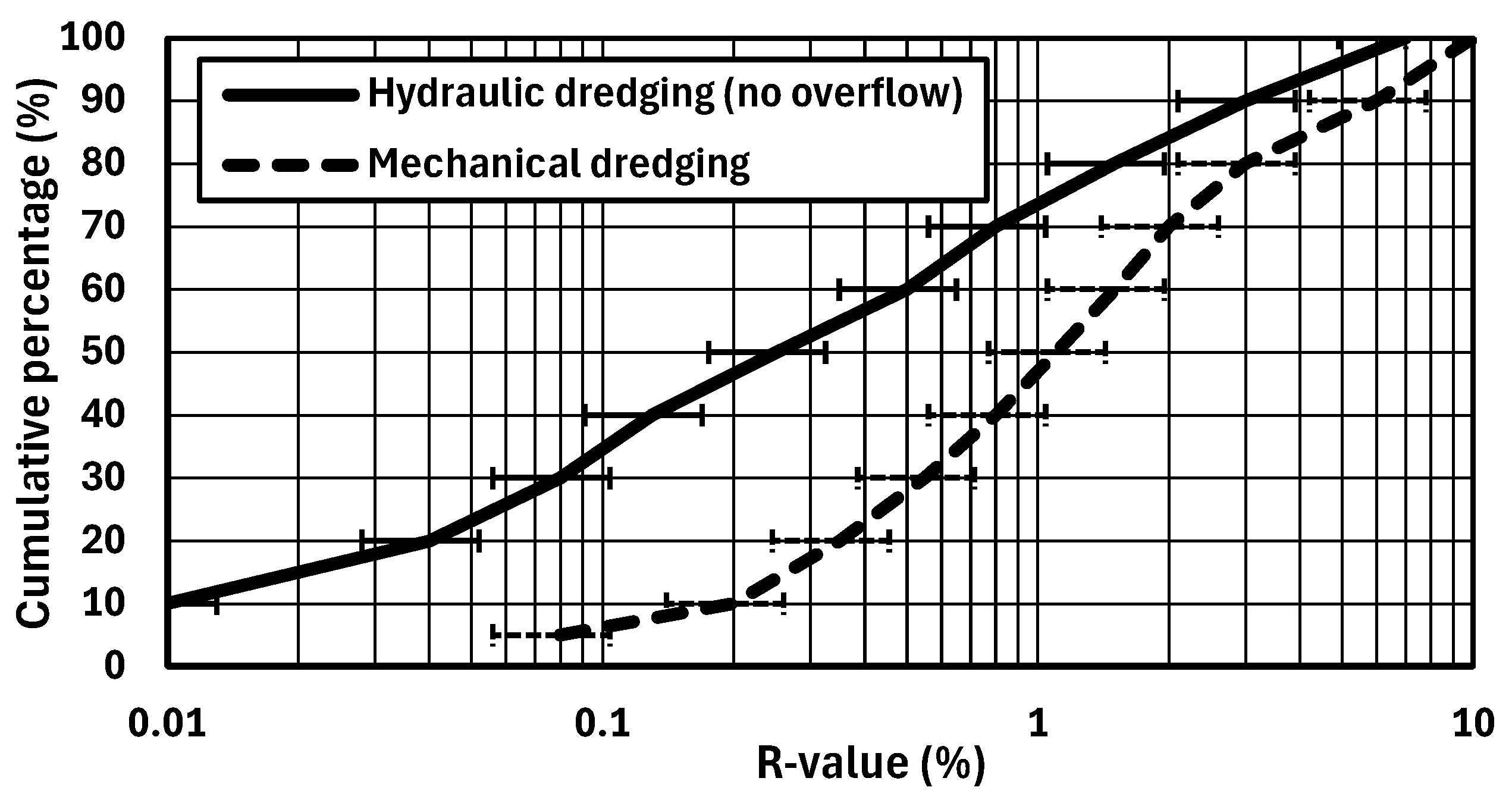
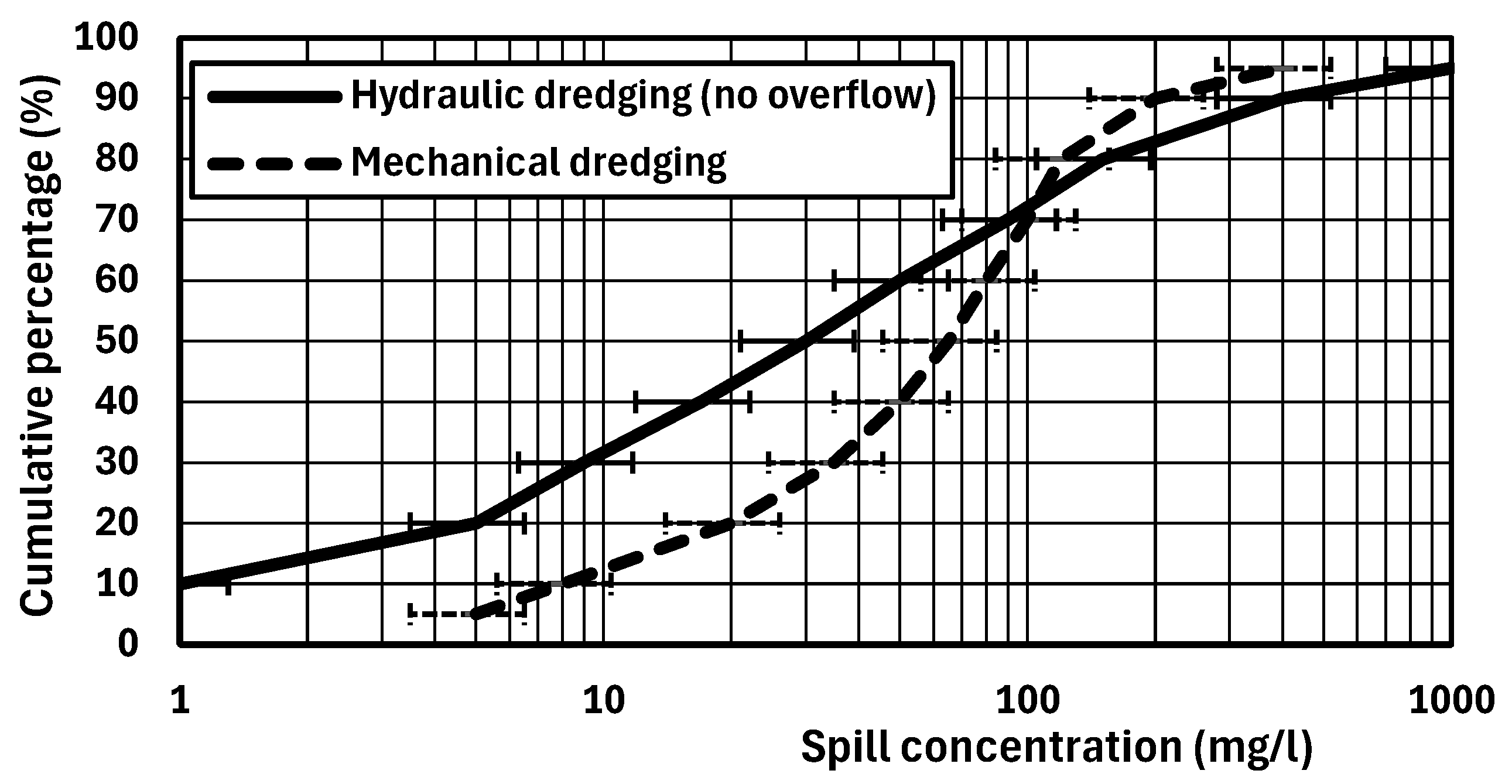
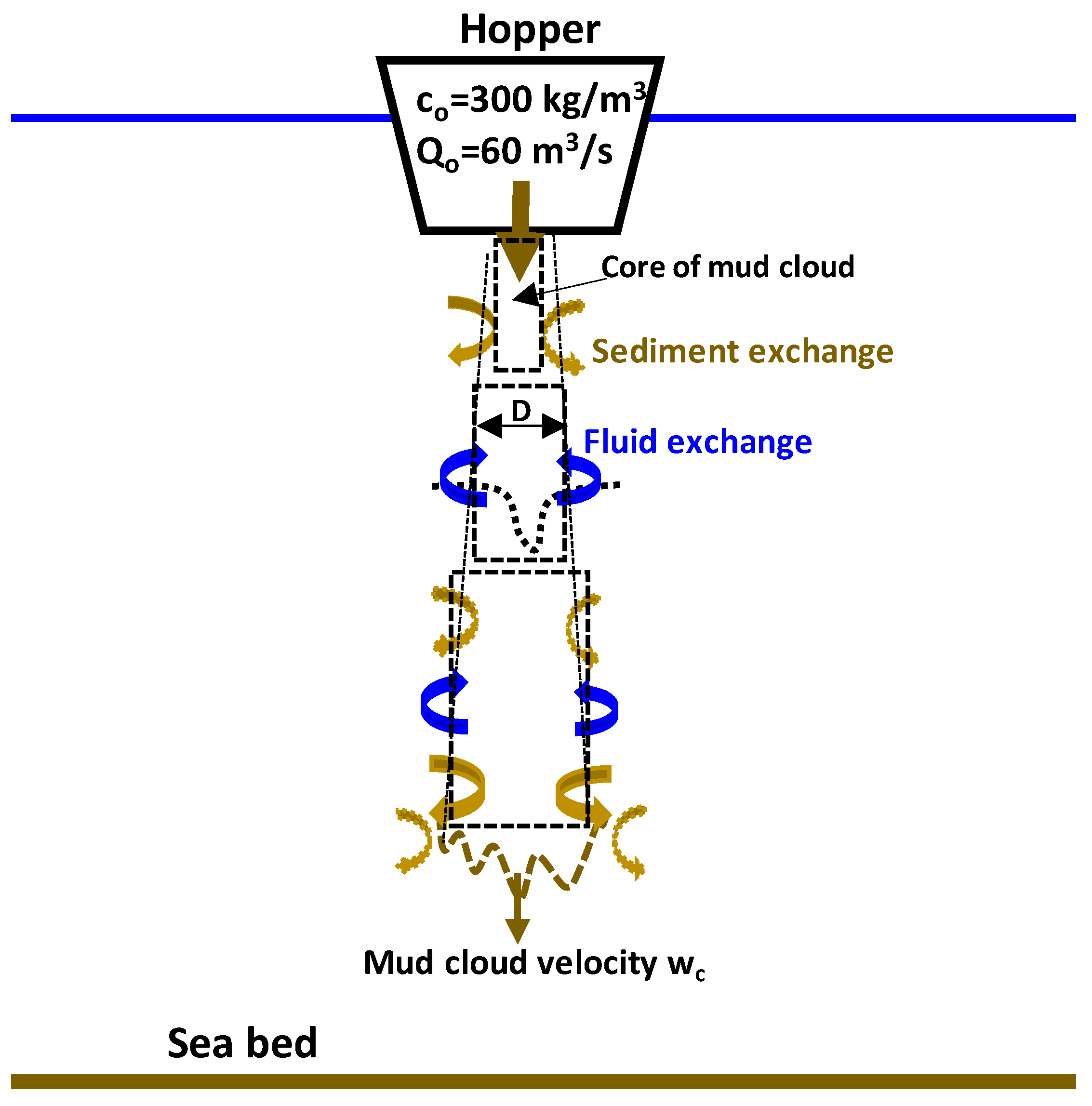
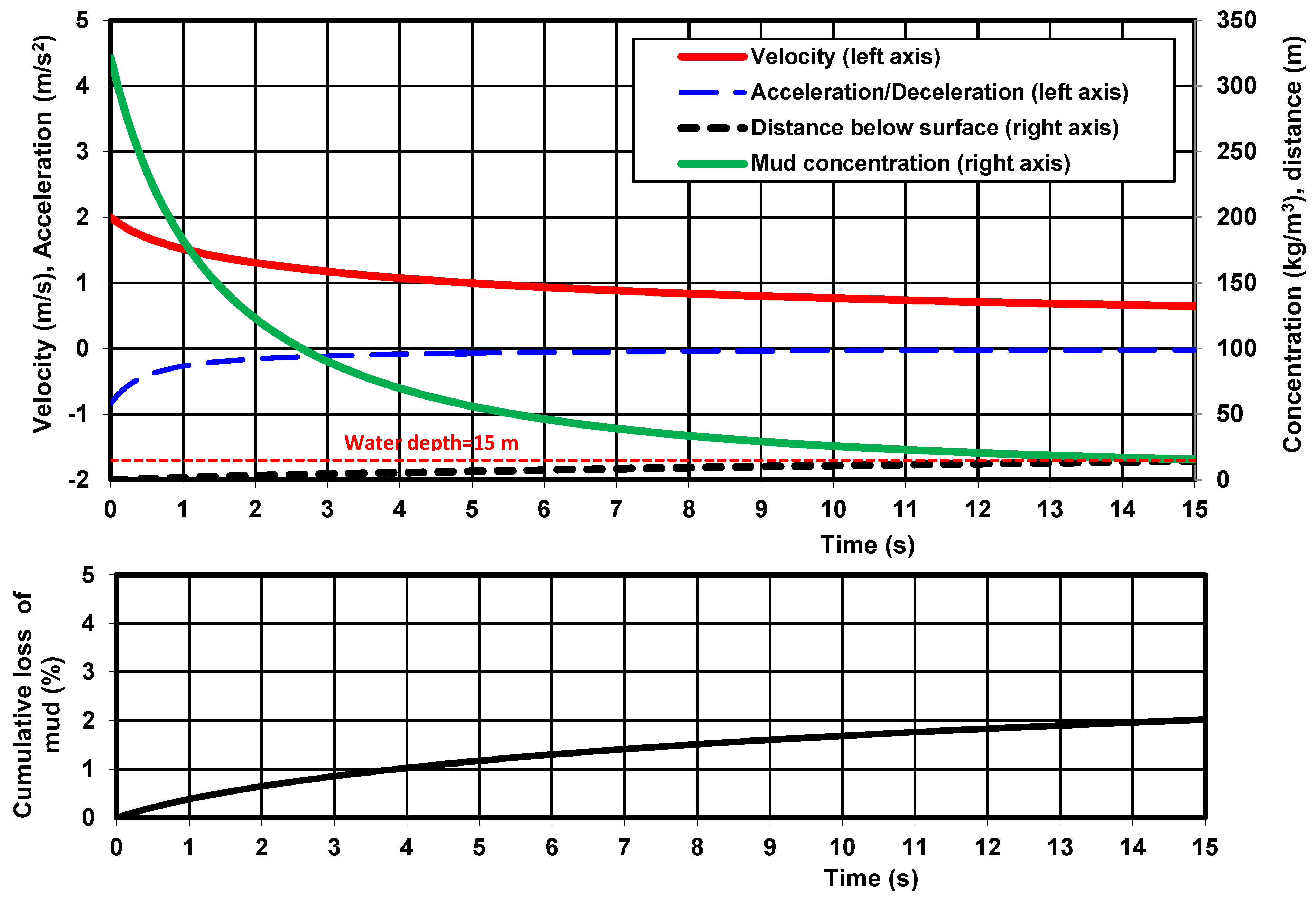

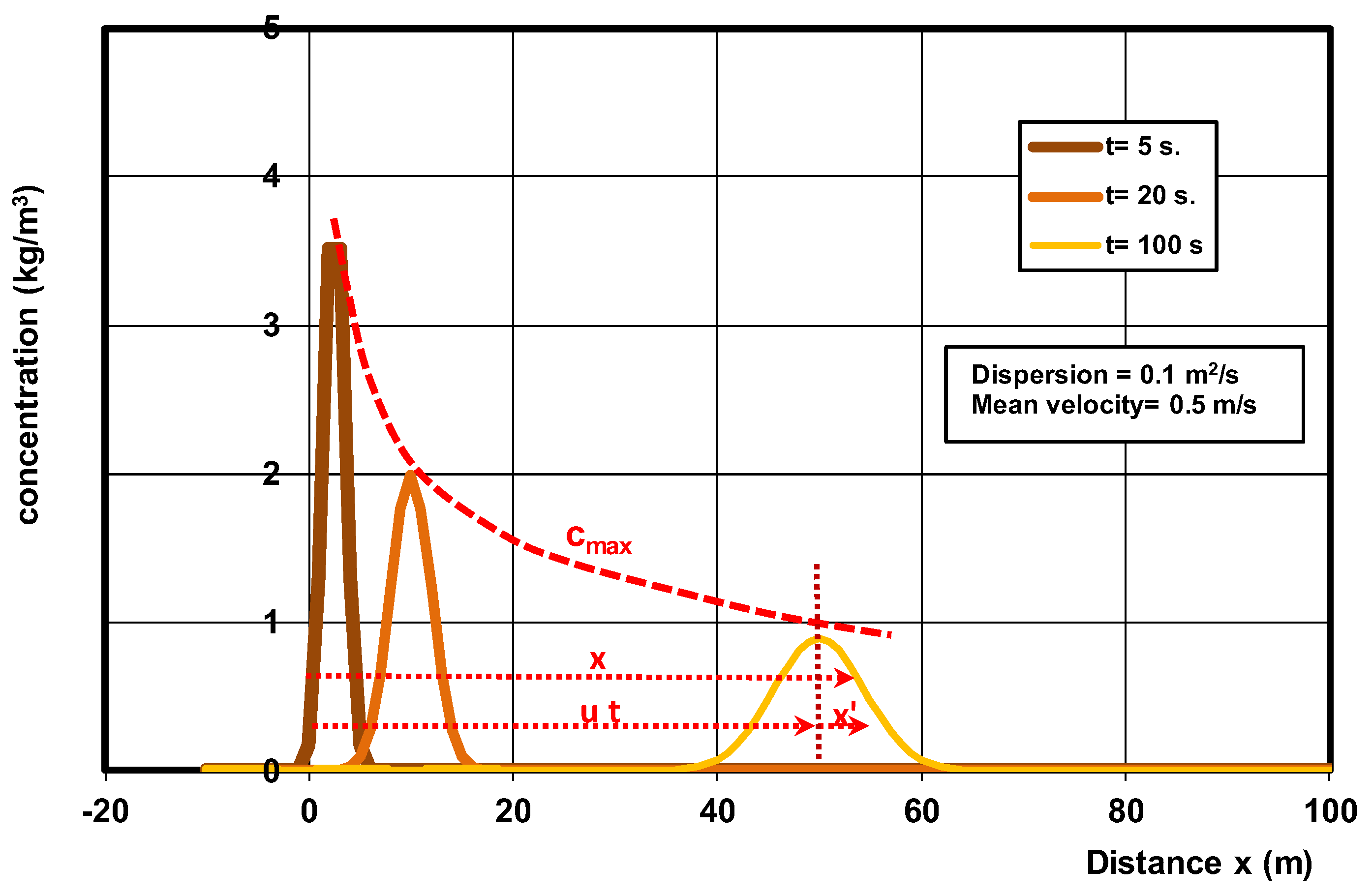
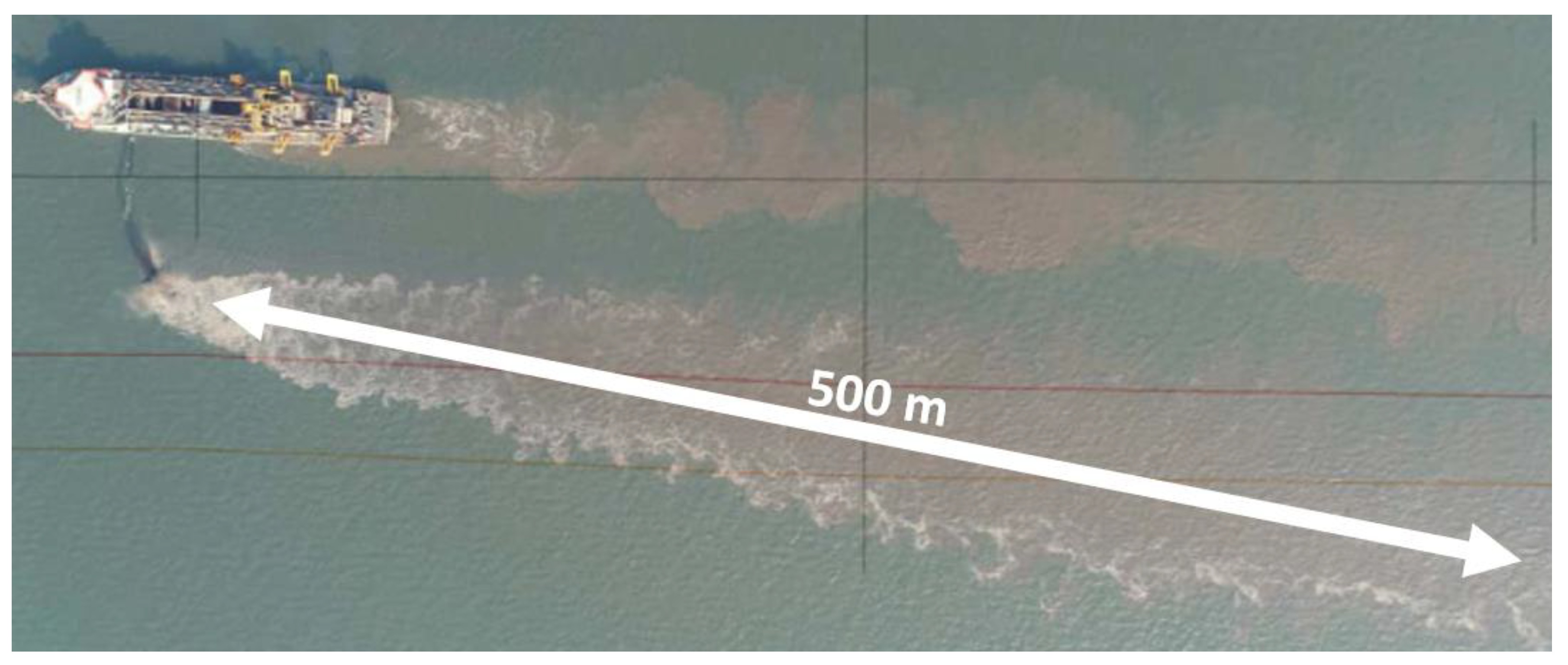


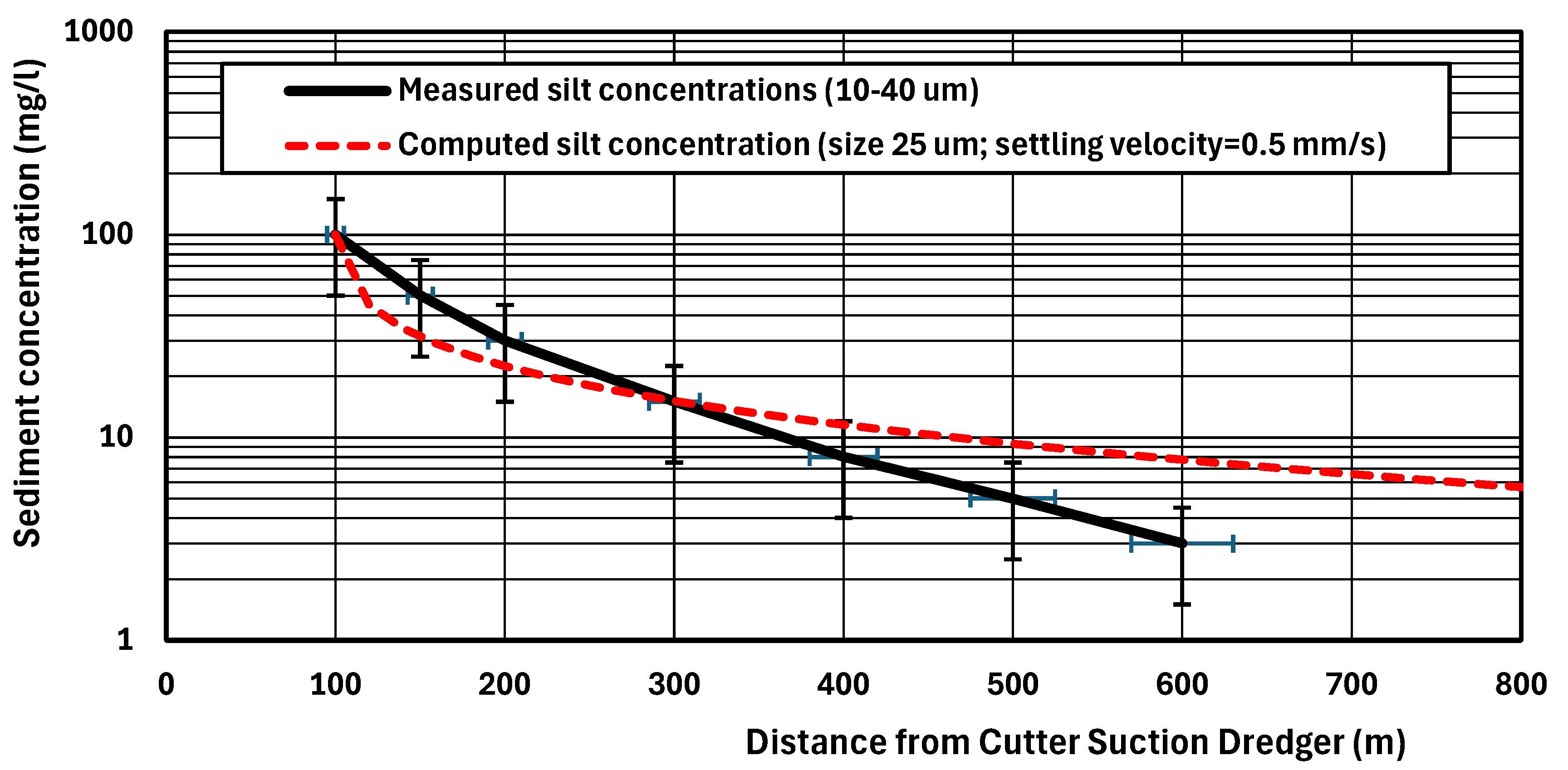
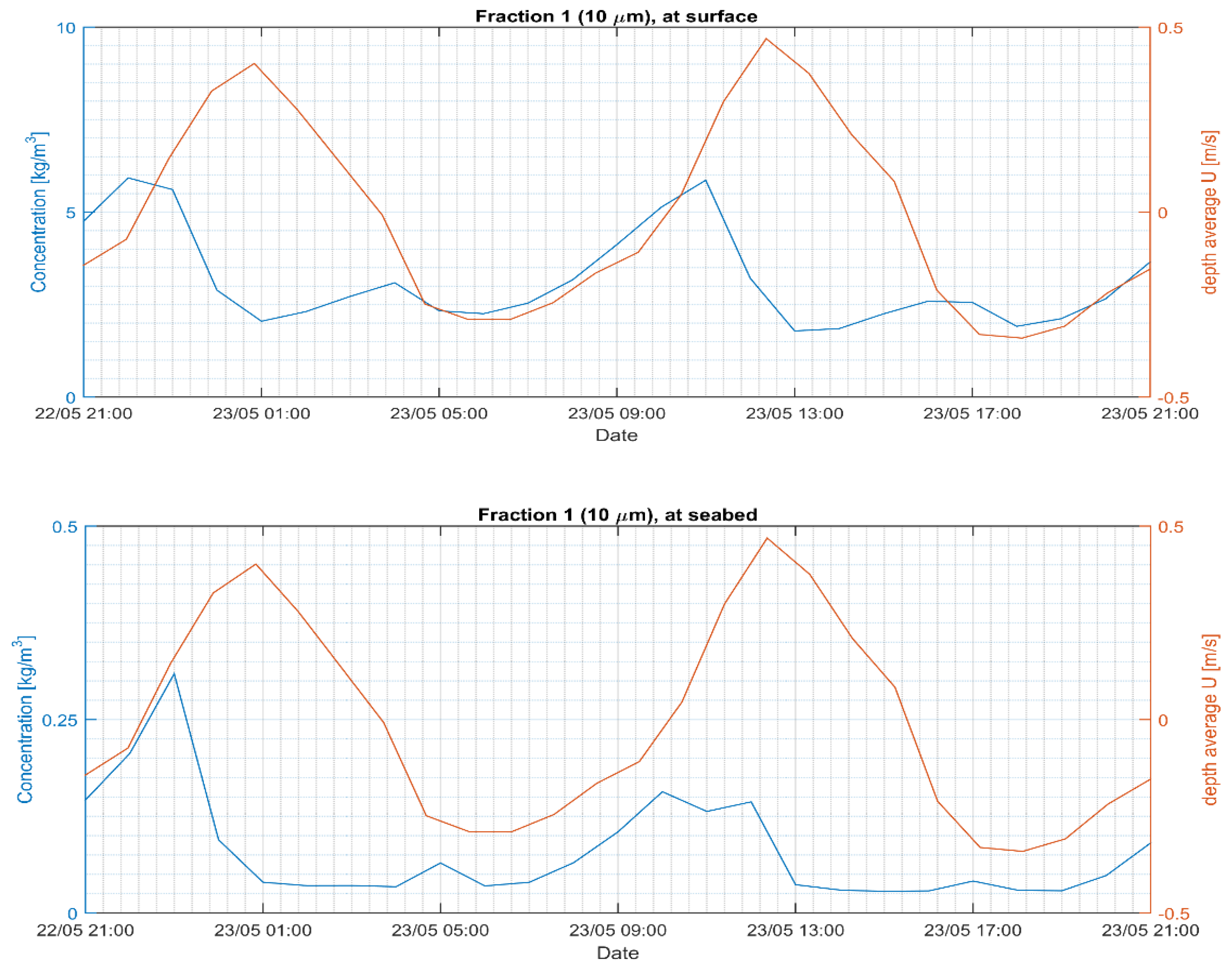
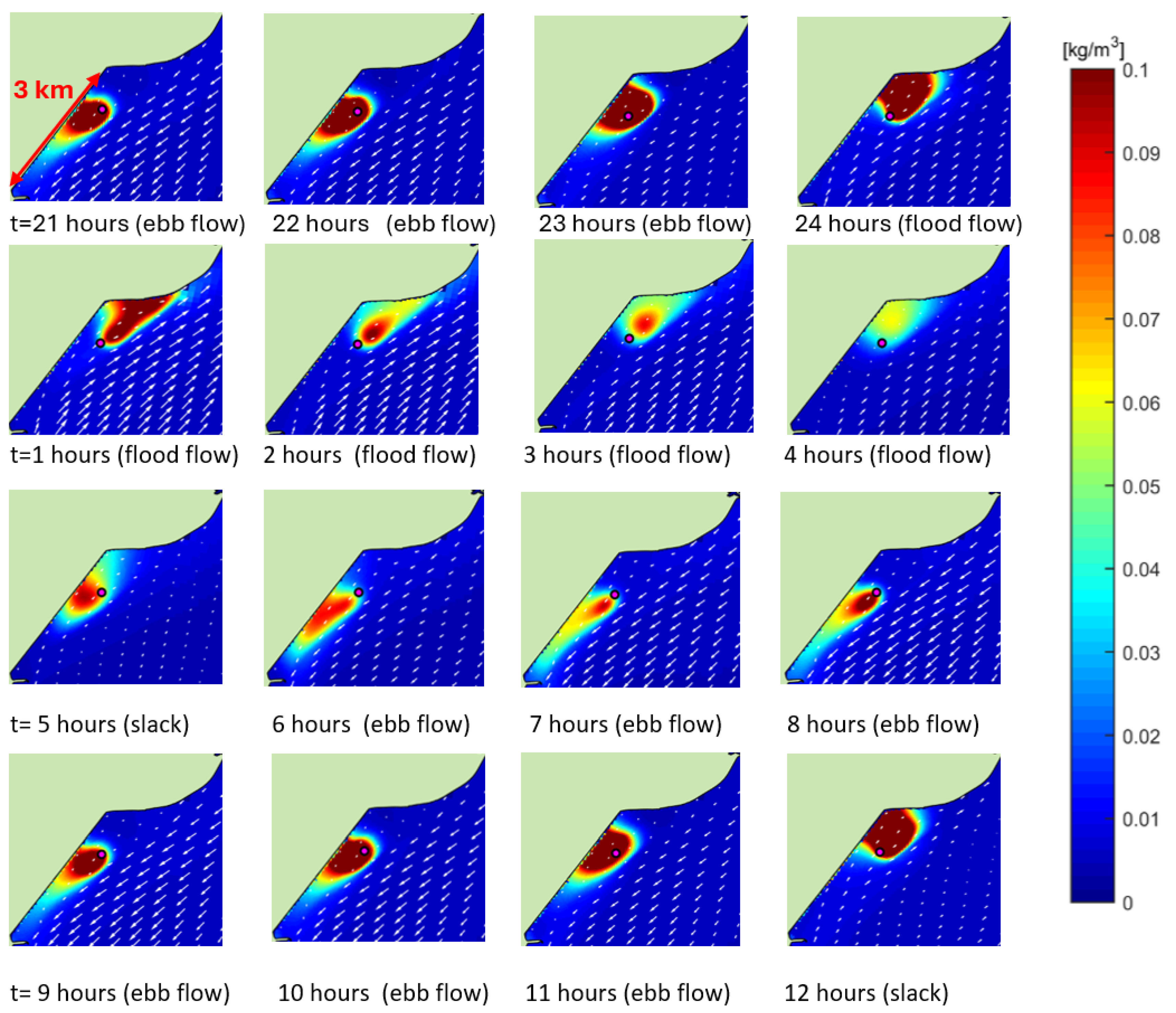
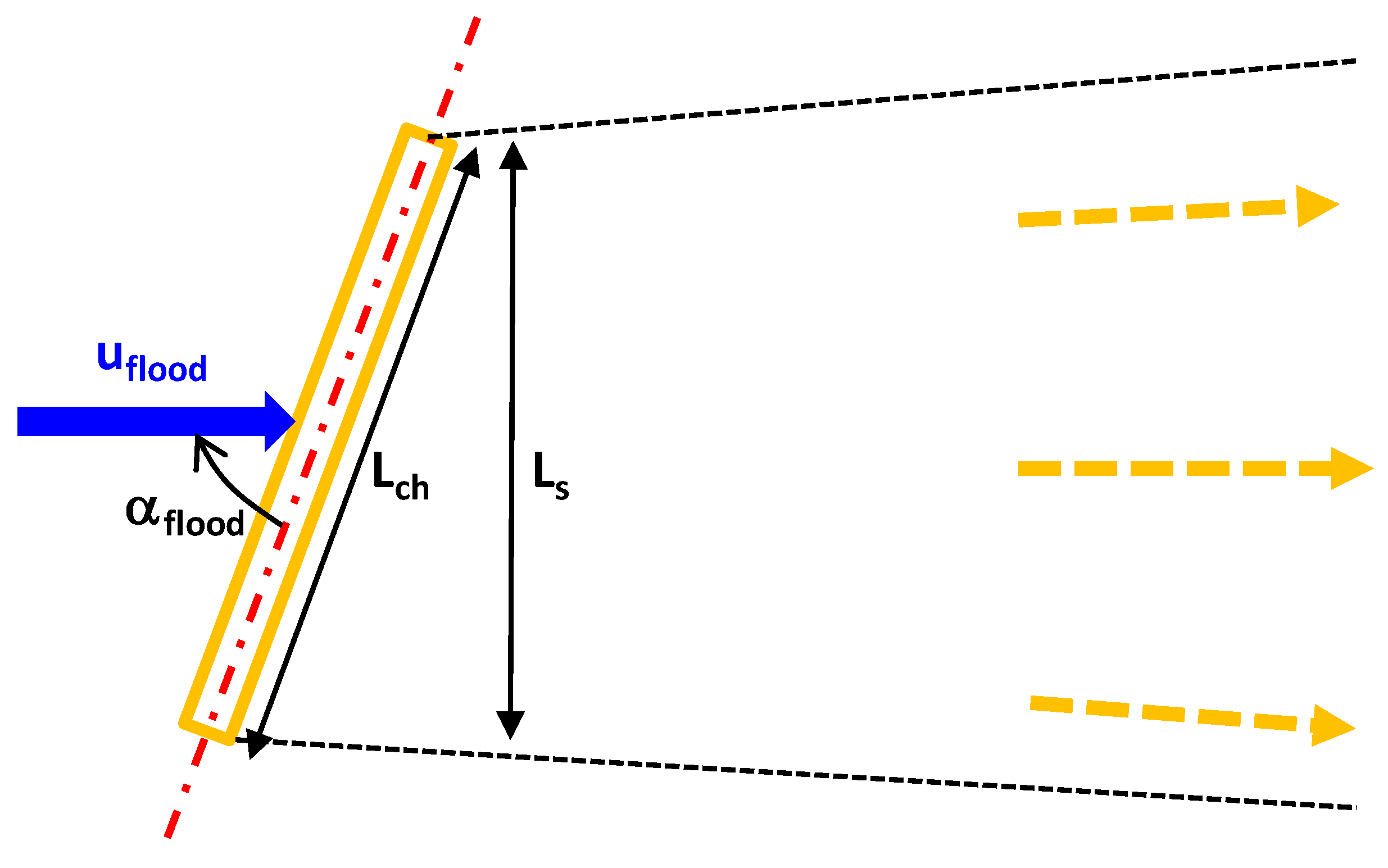
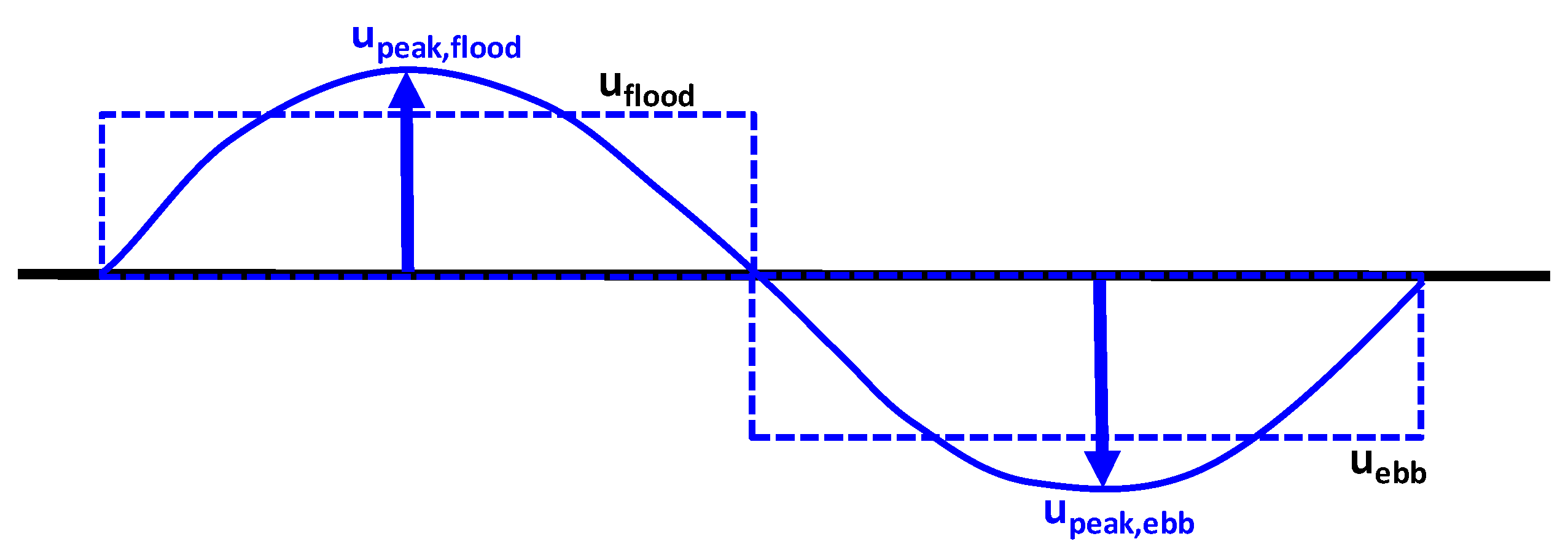
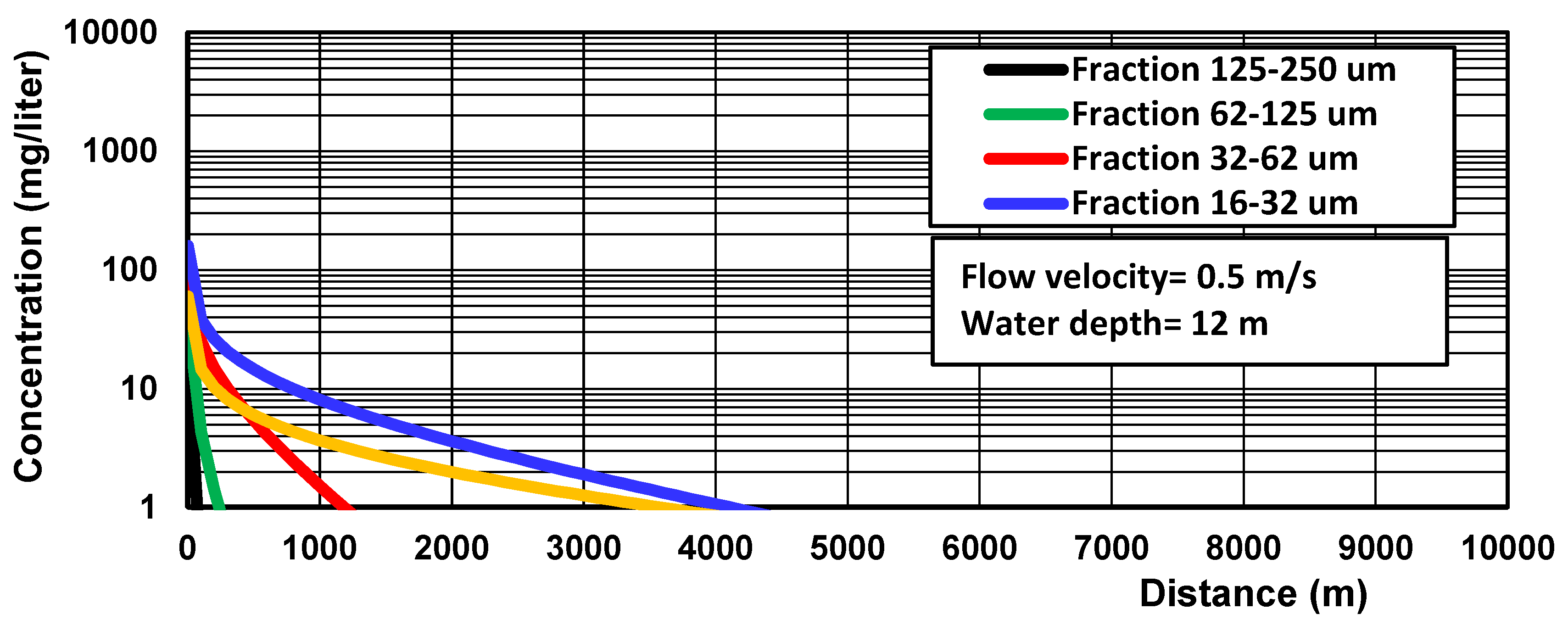
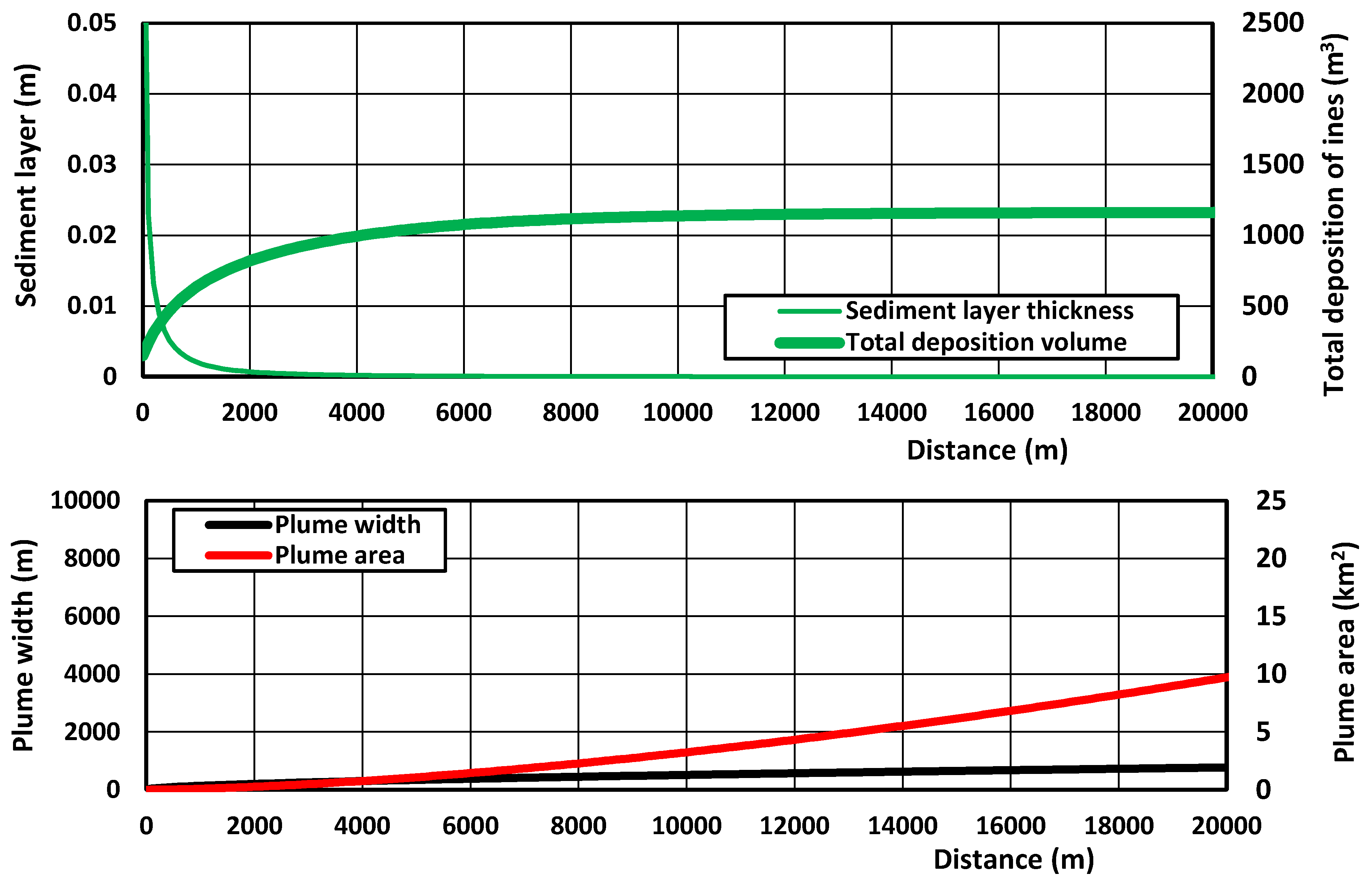
| Dredging Method | Production of Dredged Material (m3/h) | Background Concentration Cbackground (mg/L) | Increase in Concentration ∆C at 50 m (mg/L) | Decay Time ∆Tdecay After Cessation Dredging (h) | Spilling of Fines Sspill (kg/m3) | Spilling Percentage Rspill (%) |
|---|---|---|---|---|---|---|
| Large suction hopper (maximum overflow) | 4000–6000 | 50–100 | 300–1000 | 1.5 | 20–50 | 5–10% |
| Large suction hopper (limited overflow) | 4000–6000 | 50–100 | 200–400 | 1 | 10–20 | 2–5% |
| Large suction hopper (no overflow) | 4000–6000 | 50–100 | 50–200 | 0.5–1 | 5–15 | 0.5–2% |
| Small suction hopper (limited overflow) | 1500–2500 | 20–50 | 50–200 | 0.5–1 | 5–15 | 0.5–2% |
| Grab (open bucket) | 100–500 | 20–50 | 50–200 | 1 | 5–15 | 2–5% |
| Grab (closed bucket) | 100–500 | 20–50 | 20–100 | 0.5–1 | 3–10 | 1–2% |
| Bucket dredging | 300–600 | 20–50 | 50–200 | 0.5–1 | 5–15 | 2–5% |
| Large cutter | >1000 | 20–50 | 50–200 | 0.5–1 | 5–15 | 2–3% |
| Medium cutter | 200–1000 | 20–50 | 50–200 | 0.5–1 | 5–15 | 1–2% |
| Small cutter | 100–200 | 20–50 | 20–100 | 0–0.5 | 3–10 | <1% |
| Hydraulic crane (various backhoes) | 100–200 | 20–50 | 100–500 | 1 | 5–50 | 2–5% |
| Parameter | Hopper 1 Alexander von Humboldt (Jan de Nul Dredging) | Hopper 2 Gateway (BosKalis Dredging) |
|---|---|---|
| Hopper load volume (m3) | 9000 | 12,000 |
| Hopper load area (m2) | 900 | 1200 |
| Number of double doors and area per door | 7 (4.1 × 8.2 m2) | 4 (4 × 5.4 m2) |
| Effective door area (m2) and relative door area (%) | 210 (23%) | 80 (7%) |
| Opening time of doors | 70 m2 after 60 s 140 m2 after 120 s 210 m2 after 180 s | 80 m2 after 60 s |
| Disposal time to release load (s) | 60 to 100 | 180 to 300 |
| Disposal discharge (m3/s) | 150 to 90 | 120 to 180 |
| Insertion speed of load through doors (m/s) | 2 to 1 | 1.25 to 0.85 |
| Parameter | Measured Value | Model Value |
|---|---|---|
| Mud cloud density in hopper (kg/m3) | 1200 | 1200 (input) |
| Mud cloud concentration (kg/m3) | 320 | 320 (input) |
| Initial cloud diameter and height (m) | not measured | 2, 2 |
| Initial cloud velocity (m/s) | 2 | 2 (input) |
| Model parameters | - | cD = 2, fw = 0.05, α4 = 0.15; α5 = 0.001, α6 = 0.8; ∆t = 0.1 s |
| Cloud diameter near bottom (m) | not measured | 4.5 |
| Mean cloud velocity near bottom (m/s) | 0.7 | 0.7 |
| Mean cloud concentration near bottom (kg/m3) | 10 (at some distance from bed impact point) | 15 |
| Overall sediment loss from cloud | <2% | 3% |
| Time (s) | Distance (m) | Concentrations | ||||
|---|---|---|---|---|---|---|
| Current = 0.5 m/s | Current = 1 m/s | 1D Case; Longitudinal Diffusion/Mixing in Main Flow Direction; no Lateral Mixing | ||||
| ε = 0.1 m2/s | 1 m2/s | 10 m2/s | 100 m2/s | |||
| 0.1 | c ≅ 1 kg/m3 | ≅1 kg/m3 | ≅1 kg/m3 | ≅1 kg/m3 | ||
| 1 | 0.5 | 1 | c = 0.9 | 0.3 | 0.09 | 0.03 |
| 10 | 5 | 10 | c = 0.3 (γd ≅ 1/3) | 0.09 (γd ≅ 1/10) | 0.03 (γd ≅ 1/30) | 0.01 (γd ≅ 1/100) |
| 100 | 50 | 100 | c = 0.09 (γd ≅ 1/10) | 0.03 (γd ≅ 1/30) | 0.009 (γd ≅ 1/100) | 0.003 (γd ≅ 1/300) |
| 1000 | 500 | 1000 | c = 0.03 (γd ≅ 1/30) | 0.01 (γd ≅ 1/100) | 0.003 (γd ≅ 1/300) | 0.001 (γd ≅ 1/1000) |
| 10,000 | 5000 | 10,000 | c = 0.01 (γd ≅ 1/100) | 0.003 (γd ≅ 1/300) | 0.0009 (γd ≅ 1/1000) | 0.0003 (γd ≅ 1/3000) |
| Distance from Mud Source Location (m) | β = 0.5 | β = 0.7 |
|---|---|---|
| 200 | γd,lateral = 1/4 | γd,lateral = 1/9 |
| 500 | γd,lateral = 1/6 | γd,lateral = 1/15 |
| 1500 | γd,lateral = 1/10 | γd,lateral = 1/35 |
| 5000 | γd,lateral = 1/15 | γd,lateral = 1/80 |
| 10,000 | γd,lateral = 1/20 | γd,lateral = 1/125 |
| Initial Mud Concentrations | Mud Concentration Increase (mg/L) at Trench Location | |||
|---|---|---|---|---|
| Dump Site A (Flood) at 8.5 km | Dump Site B (Flood) at 3 km | |||
| SEDPLUME | DELFT3D | SEDPLUME | DELFT3D | |
| Fraction 32–63 μm; ws = 2 mm/s; c1 = 2250 mg/L | 1 | 1 | 15 | 15 |
| Fraction < 16–32 μm; ws = 0.4 m/s; c2 = 1500 mg/L | 20 | 25 | 40 | 45 |
| Fraction < 16 μm; ws = 0.1 m/s; c3 = 1250 mg/L | 30 | 35 | 45 | 55 |
| Total: co = 5000 mg/L | ≅50 mg/L | ≅60 mg/L | ≅105 mg/L | ≅120 mg/L |
| Distance from Source Location (m) | SEDPLUME β= 0.5 co = 2000 mg/L; bo = 10 m h = 1.7 m; umean = 0.3 m/s ws = 0.075 mm/s (≅10 μm) | SEDPLUME β= 0.7 co = 2000 mg/L; bo = 10 m h = 1.7 m; umean = 0.3 m/s ws = 0.075 mm/s (≅10 μm) | DELFT3D-Model co = 2000 mg/L (Depth and Tide-Averaged) |
|---|---|---|---|
| 750 | c = 210 mg/L (reduction 1/10) | c = 60 mg/L (reduction 1/35) | c = 100 mg/L (reduction 1/20) |
| 1500 | c = 100 mg/L (reduction 1/20) | c = 25 mg/L (reduction 1/40) | c = 40 mg/L (reduction 1/50) |
Disclaimer/Publisher’s Note: The statements, opinions and data contained in all publications are solely those of the individual author(s) and contributor(s) and not of MDPI and/or the editor(s). MDPI and/or the editor(s) disclaim responsibility for any injury to people or property resulting from any ideas, methods, instructions or products referred to in the content. |
© 2025 by the author. Licensee MDPI, Basel, Switzerland. This article is an open access article distributed under the terms and conditions of the Creative Commons Attribution (CC BY) license (https://creativecommons.org/licenses/by/4.0/).
Share and Cite
van Rijn, L.C. One-Dimensional Plume Dispersion Modeling in Marine Conditions (SEDPLUME1D-Model). J. Mar. Sci. Eng. 2025, 13, 1186. https://doi.org/10.3390/jmse13061186
van Rijn LC. One-Dimensional Plume Dispersion Modeling in Marine Conditions (SEDPLUME1D-Model). Journal of Marine Science and Engineering. 2025; 13(6):1186. https://doi.org/10.3390/jmse13061186
Chicago/Turabian Stylevan Rijn, L. C. 2025. "One-Dimensional Plume Dispersion Modeling in Marine Conditions (SEDPLUME1D-Model)" Journal of Marine Science and Engineering 13, no. 6: 1186. https://doi.org/10.3390/jmse13061186
APA Stylevan Rijn, L. C. (2025). One-Dimensional Plume Dispersion Modeling in Marine Conditions (SEDPLUME1D-Model). Journal of Marine Science and Engineering, 13(6), 1186. https://doi.org/10.3390/jmse13061186





